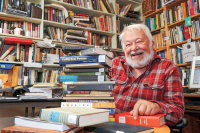Unraveling the story of Horace Kephart’s ‘drying out’
 George Ellison’s response to Gwen Breese’s letter regarding his article on Horace Kephart and his condition when he arrived at Hazel Creek states, correctly, that as someone who is working on a biography of Horace Kephart, he is “obligated to examine, as best I can, each episode in Kephart’s life in the light of available evidence.” We wholeheartedly agree with that obligation. However, the information and supposed evidence which Ellison offers in an effort to describe Calhoun’s story of the meeting with and “drying out” of Kephart as nothing more than the equivalent of a “tall tale spun by Mark Twain” is at best open to serious question and at worst highly suspect. Here are some of the reasons why this rewriting of history is so fraught with problems.
George Ellison’s response to Gwen Breese’s letter regarding his article on Horace Kephart and his condition when he arrived at Hazel Creek states, correctly, that as someone who is working on a biography of Horace Kephart, he is “obligated to examine, as best I can, each episode in Kephart’s life in the light of available evidence.” We wholeheartedly agree with that obligation. However, the information and supposed evidence which Ellison offers in an effort to describe Calhoun’s story of the meeting with and “drying out” of Kephart as nothing more than the equivalent of a “tall tale spun by Mark Twain” is at best open to serious question and at worst highly suspect. Here are some of the reasons why this rewriting of history is so fraught with problems.
• Ellison has Calhoun meeting Kephart at the “Bushnell depot at the mouth of Hazel Creek.”
In his piece of July 30, 2014, as well as in earlier material he quotes (the original Smoky Mountain News piece of November 2013 and an even earlier Afterword to Gary Carden’s play, “Outlander”), Ellison repeatedly places Bushnell at the confluence of Hazel Creek and the Little Tennessee River. In so doing he makes a serious geographical mistake. The thriving community of Bushnell, long since inundated by the waters of Fontana Lake, lay a dozen miles upstream at the juncture of the Tuckasegee and Little Tennessee Rivers.
• Ellison places considerable reliance on the index to the lost Kephart diaries.
First of all, although Kephart chose the term and it heads the handwritten version of his notations, it really isn’t an index at all. Rather, it is a rough table of contents, and while Ellison cites the relevant dates of coverage as Nov. 1, 1904 onward, there are no actual dates with the notes. In all likelihood this index was handwritten well after Kephart first journeyed to Hazel Creek, and numerical cross-references are suggestive in this regard. A typewritten page of weather-related observations does have dates, but the typing was clearly done after the fact — most likely in Bryson City. Accordingly, just as Ellison suggests that time may have dimmed the accuracy of Calhoun’s recollections, one could justifiably say the same was true of Kephart.
• The putative entries for the day he traveled to Medlin and the home of Granville and Lillie Calhoun includes an entry involving the “Grade at Nantahala.”
Related Items
If Kephart is noting things he observed along the way as Ellison indicates, he would have certainly taken a tortuous route to reach his destination. Even the mouth of the Nantahala, where there was nothing of particular note related to the grade, was at Almond, over seven miles beyond the depot at Bushnell where Kephart disembarked — and also in exactly the opposite direction of that from Bushnell to Medlin. One simply did not go from Dillsboro to Bushnell, let alone Hazel Creek, by way of Nantahala.
• One of the diary index entries in the section cited by Ellison was “Barefoot kid (chores, barefooted in snow).”
A review of weather data from four Western North Carolina stations (courtesy of the State Climate Office of North Carolina) operating during the period from Oct. 24 until Nov. 2, 1904, was conducted to provide a frame of reference. During that 10-day period from more than a week before the date of the trip indicated by Ellison through a day after it was made, the sum of the recorded precipitation at Murphy, Bryson City, Waynesville and Hendersonville was precisely zero inches. The average daily high temperatures for Waynesville and Hendersonville during that period (Bryson City and Murphy temperatures were not recorded) were 67 degrees and 63 degrees, respectively, with the minimum daily high for the entire period being 55 degrees occurring at Hendersonville on Oc. 24. The data speak quite clearly for themselves. Further, the mention of a barefooted boy doing chores in the snow is quite suspect. Exposure of this sort would have meant frostbite in short order.
• Ellison contends that Calhoun’s story had “all the earmarks of a tall tale out of Mark Twain.”
One of Granville Calhoun’s recollections recorded by Frome was (in response to difficulties Kephart was having riding the mule) “Pick it up! Sixteen miles to go!” The single category where exaggeration is most likely to occur with any story is that of measurements, whether in terms of inches of fish, pounds of bear, or miles walked to school. Yet given this prime opportunity to exaggerate, Calhoun laid the story down precisely, as validated by postal route data from 1896:
http://dc.lib.unc.edu/cdm/singleitem/collection/ncmaps/id/611/rec/1
• Ellison mentions that George Frizzell and Dan Pierce “agree with my conclusion — based on currently available documentation — that there was evidently no three-week interval at that time of ‘torpor and tremens’ and ‘spoon-feeding.’”
After assiduous searching we have found no evidence whatsoever of such support. Nowhere in his book, The Great Smokies: From Natural Habitat to National Park, does Pierce even mention Kephart’s relationship with Calhoun. Similarly, he does not seem to have written other books or articles on the subject. Likewise, no published material from Western Carolina University archivist George Frizzell addresses this particular matter. If these scholars support Ellison’s view, he needs to provide specific documentation to that effect.
• Ellison seems to dismiss the accounts Granville Calhoun offered to Michael Frome, Carson Brewer and “regional columnists” as unreliable. He also implies that Frome’s research was shoddy, saying Frome failed to indicate “much, if any, awareness that Kephart was not coming directly from St. Louis to Hazel Creek.”
That is simply untrue. Frome specifically mentions Kephart staying in a Sylva hotel and meeting Jack Coburn (he does not mention Coburn by name but merely refers to him as a “mining man”) prior to going to Hazel Creek. Furthermore, Frome’s research techniques were admirable. He carefully taped his interviews and clearly delved deeply into Kephart’s writings, as is indicated by his comment that “he degraded himself in his more drunken times with sloppy work for so-called adventure magazines.” This likely refers to some of Kephart’s columns in All Outdoors, for at times that column, “Roving with Kephart,” is little more than the same sort of sensationalism which unfortunately characterizes portions of Our Southern Highlanders (particularly the chapter entitled “The People of the Hills”).
In the final analysis, the dividing line between fact and fiction when it comes to the early weeks of Kephart’s stay at Medlin boils down to whether you believe a latter-day interpretation of sparse notes written by Kephart or the personal recollections of Calhoun, as he related the event to multiple parties. The point Gwen Breese clearly made in her letter was that her great-uncle was a highly reliable source. That is evidenced not only by family recollections which Ellison dismisses as “family lore” but by the fact that throughout his life he held numerous positions where honesty was an essential element in retaining community trust.
All who knew Calhoun considered him a man of impeccable integrity, someone who was a stickler for the truth (at one point late in life he reckoned he was going to have to quit talking to John Parris, a columnist for the Asheville Citizen-Times, because of the way he was inflating and romanticizing stories Granville shared with him), and an individual whose mind was as sharp as a well-honed pocket knife at the time he was interviewed by Frome.
Kephart, on the other hand — and to his credit Ellison acknowledges as much — was a “chronic alcoholic” and “binge drinker” who remained so “until the day of his death.” That being the case, an episode of the type Calhoun recounts seems possible, indeed likely. It is also worthy of note that at least five local individuals who knew Kephart quite well (S. W. Black, Dr. Kelly Bennett, Buddy Abbott, Petie Angel and Helen Angel) recalled similar situations where Kephart went on a “toot” and subsequently required “drying out.” For our part, based in part on the respective characters of the two men but also on the myriad problems noted above, we will adhere to Calhoun’s account rather than Ellison’s startling revision.
Don Casada, Bryson City
Jim Casada, Rock Hill, S.C.
Editor’s note: A column published by Geroge Ellison on Nov. 6, 2013, (www.smokymountainnews.com/component/k2/item/12045) has sparked rebuttals from Swain County residents. One from Gwen Breese appeared in the July 9 edition of SMN (www.smokymountainnews.com/opinion/item/13699). Ellison’s response to that letter appeared in the July 30 edition of SMN (www.smokymountainnews.com/news/item/13915-looking-back-at-strawberry-wine-kephart-and-calhoun). This letter is by brothers Jim and Don Casada. I have another in my computer queue that will run in next week’s edition.
Since Calhoun and Kepart are important figures in the history of this region, we plan to continue to publish credible, relevant information pertaining to this incident.
— Scott McLeod, Publisher









